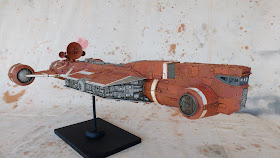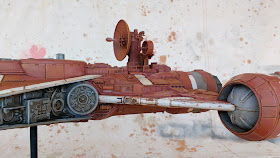Back in the part 1 of this project I described making some adapters out of PVC to adapt the angled shock mounts on the Venom Creeper axles to support a vertical shock position and a sway bar link.
One of these broke with the model just sitting there doing nothing and I realised they were not up to the task. I needed to find a solution for the project to progress.
Four years later it dawned on me while waiting for a cycle to finish on the CNC lathe at work on how to make a better adapter fairly easily. The solution was to make it from some aluminium sheet and twist it in the middle to compensate for the angled axle shock mounts.
 |
| Original PVC adapters with the prototupe aluminium adapter below. |
I made a prototype to see if I could make it work and it seemed like it would do the job so I made 4 good ones and fitted them to the axles. I made them by hack-sawing and filing some pieces of aluminium strip and placed each end in turn in a vice and twisted the middle to the required angle using a adjustable spanner. The two end holes were tapped M3 for the shock ends and sway bar linkage and the middle hole drilled out 3.1mm for clearance on the M3 through bolt and aluminium spacer which attaches them to the axle shock mounts.
With that obstacle out of the way the project continued and I did the work on the cockpit. Next up was paneling the hull.
This was the hull as it has been sitting for 4 years.
I took that photo into photoshop and scribbled away very roughly to get some ideas for a panel layout. The picture below shows what ended up after a few rejected ideas and was enough to move on to a cardboard trial template which in turn lead to cutting some 1mm styrene.
 |
| Very rough scribbles in photoshop is all I needed to generate an idea for the paneling concept. |
 |
| Cardboard trial template on left, 1mm styrene panel on the right. |
I wanted to try for a sort of Data70 feel to the paneling. Data70 was a font designed in 1970 which when I was a kid represented the coolest sci-fi look ever.
Each panel was cut out using a step drill to cut the 12mm radius corners, an olfa knife cutting the straight lines with a metal ruler and a dremel sanding drum to complete. The panels had to be carefully pre-bent to match the curve of the hull. Some of the 1mm styrene was brittle due to sunlight and just broke up so frustratingly a few panels had to be made twice. The underlying skin on the hull was also made from the same batch of 1mm styrene and where it has seen some indirect sunlight it had started to craze and crack in a few places. I think the black styrene is more susceptible to this than the usual white styrene. The new panels have helped to reinforce the thin hull considerably and with the eventual addition of paint I don't foresee the cracking being an issue in the future.
There is more surface paneling to be done and a couple of solar panels to made for the top and a little more detailing still to go before I get to the primer stage.
The hull is increasing in weight as the panels and detailing are added. So far the shocks in which I added extra springs at the start of the project are holding up the weight just fine. I may need to make stiffer sway bars to correct any lean if it appears.
I would like to get the wheels anodised red to tie in with the rest of the colour accents on the chassis and maybe the chassis frames as well though that may prove to be outside my budget.
Thanks for looking.
More soon...
Part 1, Part 2, Part 3, Part 4, Part 5, Part 6, Part 7,






















































